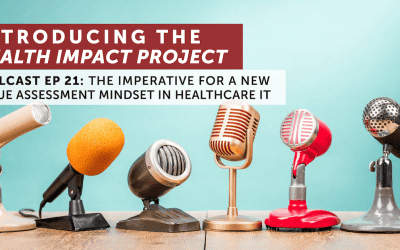Breaking the Death Grip of Legacy Technologies
Willy C. Shih for Harvard Business Review
“Every industry sector must deal with legacy systems and healthcare is no different. Good article on why legacy systems and processes can seemingly have a death grip on organizations – as the saying goes, culture eats technology for lunch. It may be some time before we see any drastic improvement in healthcare as a result of current IT investments. But those that can disrupt through rapid transition(s) away from legacy models and systems could gain significant advantage.” – John
Doctoring, Without the Doctor
Sabrina Tavernise for The New York Times
“Small victories for legions of nurses across the country: Nurses have long been shackled in their ability to provide patient care without oversight from a physician, until a recent wave of state policies have overturned those restrictions. The primary care shortage is well known, yet the American Medical Association persists in fighting these new reforms. Their intentions may be for the best, but their shortsightedness is plain for everyone else to see. What is particularly revealing is the comments section, where doc after doc chimes in about malpractice.” – Naveen
Tech Rivalries Impede Digital Medical Record Sharing
Robert Pear for The New York Times
“While many describe any federal effort to directly outlaw information blocking as a dead letter or a paper tiger, Congress continues to move such efforts along. This article has links to the pertinent legislation as it starts taking shape. This proposed civil offense, like everything related to healthcare interoperability, is part sabre rattling and part a sincere effort to help solve a costly and difficult impediment to the transition to VBP.” – Brian
Telemed docs more likely to prescribe broad-spectrum antibiotics
Steven Ross Johnson for Modern Healthcare
“In a recent study, physicians on Teladoc had comparable rates of antibiotics prescriptions compared to in-person office visits, but tended to use “wide spectrum” drugs rather than more precise antibiotics. One researcher guessed it was likely that the lack of information garnered during a virtual visit (compared to a regular one) was driving this disparity. The implication of course is the spread of antibiotic-resistant strains of bacteria. We can assume there will be other unanticipated wrinkles such as this as the adoption of telehealth grows in popularity.” – Naveen
For Many Patients, Delirium Is A Surprising Side Effect Of Being In The Hospital
Sandra G. Boodman for Kaiser Health News
“Alzheimer’s and dementia among the elderly get all of the headlines but delirium can affect anyone who has the misfortune to be hospitalized. This condition is often overlooked and rarely diagnosed given the constellation of other problems afflicting patients. This review suggests that as many as 40% of cases are preventable. While this article points to no technology fixes it does suggest that closer attention to the evidence base could reduce the incidence.” – Brian
IBM’s Dr. Watson Will See You…Someday
Brandon Kaim for IEEE Spectrum
“Wherefore art thou, Watson? After 4 years of much-hyped up promises of bringing AI to healthcare, Watson seems to have stagnated. This article explores some of the specific factors that have snagged IBM’s brainchild, as well as some of the broader morass inherent to healthcare. Importantly, it highlights some of the other AI initiatives that are being brought to bear on care delivery around the country.” – Naveen
Op-Ed: Two US Senators explain why Congress must unite around PATENT Act
Senators Chuck Schumer and John Cornyn for Ars Technica
“Two senators don’t like patent trolls. This open letter talks in vague generalities about their proposed solution: the PATENT Act. The toothiest provision of this proposal would be a losing-party-pays rule for patient-related litigation. For now, these nuisances are a perfectly legal and legitimate way to make a living while stifling innovation.” – Brian
So What is Interoperability Anyway?
John Halamka in Life as a Healthcare CIO
“John Halamka takes a passionate stand on how to improve interoperability. In light of broad criticism, now coming from the highest levels of the country, Halamka argues that legislation and regulation are not the next step to achieve the promise of meaningful interoperability between systems. Rather he posits we should begin discussing “a crisp set of requirements for care management and care coordination with defined metrics of success.” He also points out 5 specific focus areas the ONC could double down on in order to facilitate industry-wide movement on the issue, including among others, a (voluntary) national identifier for patients.” – Naveen
Hospitals Expected More of a Boost From Health Law
Christopher Weaver for The New York Times
“Medicaid expansion under the ACA didn’t provide non-profit hospitals with the additional revenue they expected, according to a new report from Moody’s. Performance improved across the board, even in the states that opted out of Medicaid expansion, due to a decline in unemployment and a boost in the economy. Although hospitals in expansion states expected that fewer unpaid bills and a larger population of paying customers would translate to improved cash flow and operating margins, that hasn’t been the case according to the report. Last year unpaid bills at hospitals in expansion states fell 13 percent compared to 2013, but their operating margins didn’t improve any more than those of their counterparts in the 22 non-expansion states. Important trend to follow especially as more risk is being passed on to hospitals and if there is any fiscal improvement this year as ACA enrollment continues to increase.” – Matt
A Talking Teddy Bear Practicing in the Pediatric Hospital
Emma Cott for The New York Times
“This is some really cool stuff. An animatronic teddy bear is being used to help children in hospitals. It interacts with the patients through a remote operator, records physiological activity via a number of wearables, and captures kids’ emotions through video. It is being used as a study – but it’s clear that this sort of innovation is helping restore a sense of patient-centeredness and humanity to the inpatient stay.” – Naveen




0 Comments